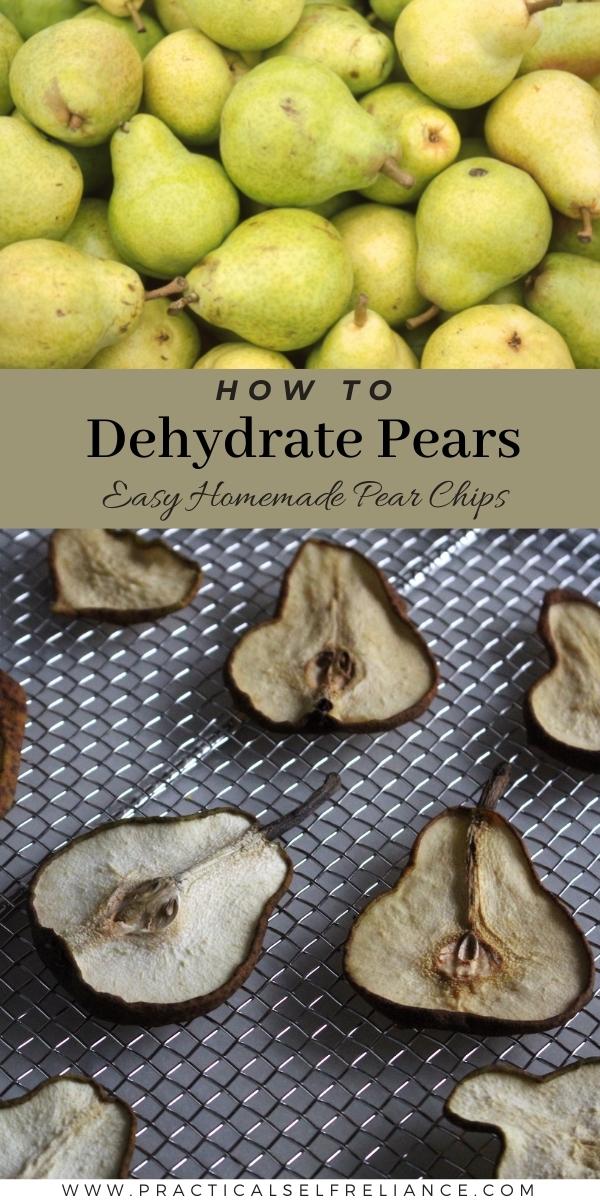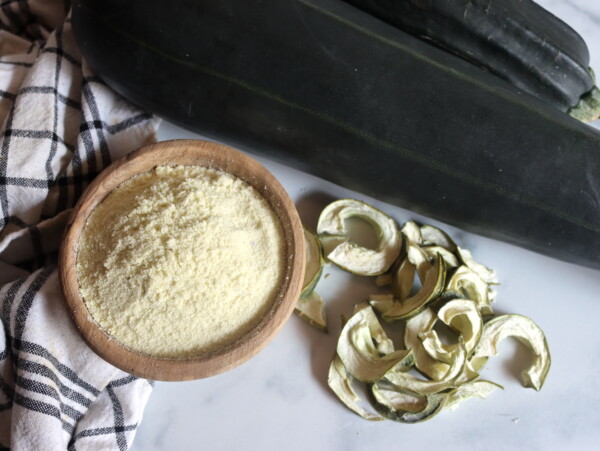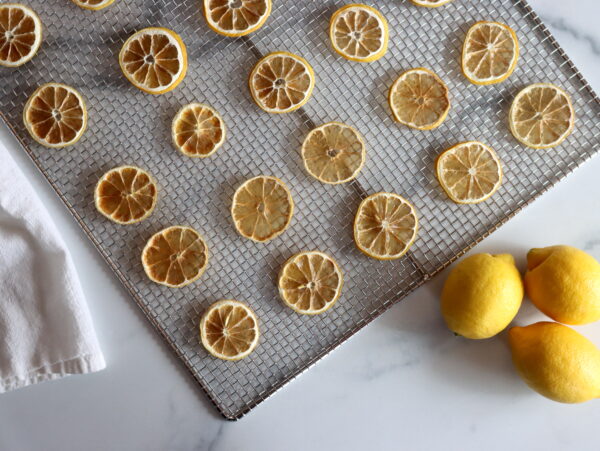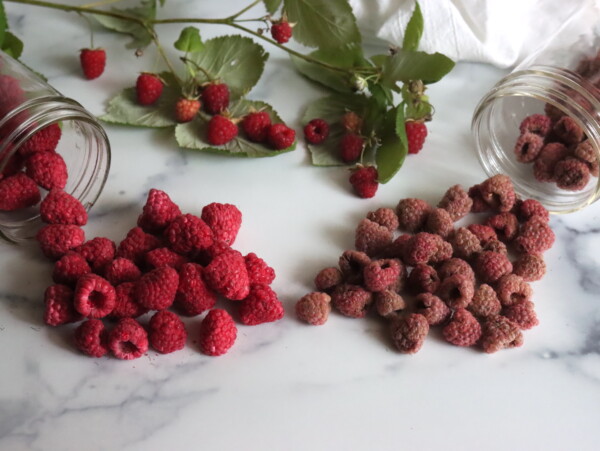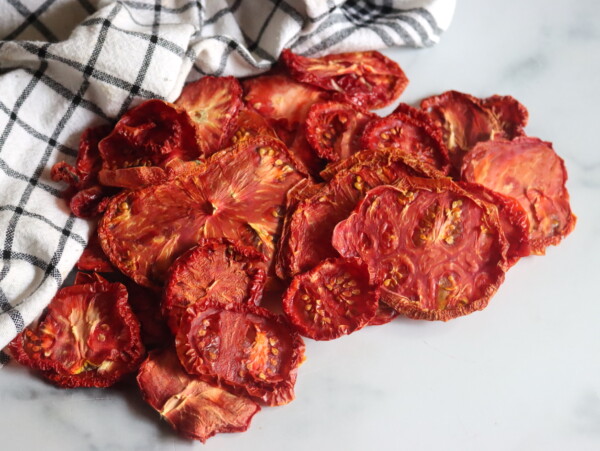Affiliate disclosure: This post may contain affiliate links. Please see our Privacy Policy.
Drying pears at home is a simple way to preserve this fruit for a healthy snack right from your own pantry. These sweet fruits don’t keep long when fresh, but they store wonderfully as dried pear chips!
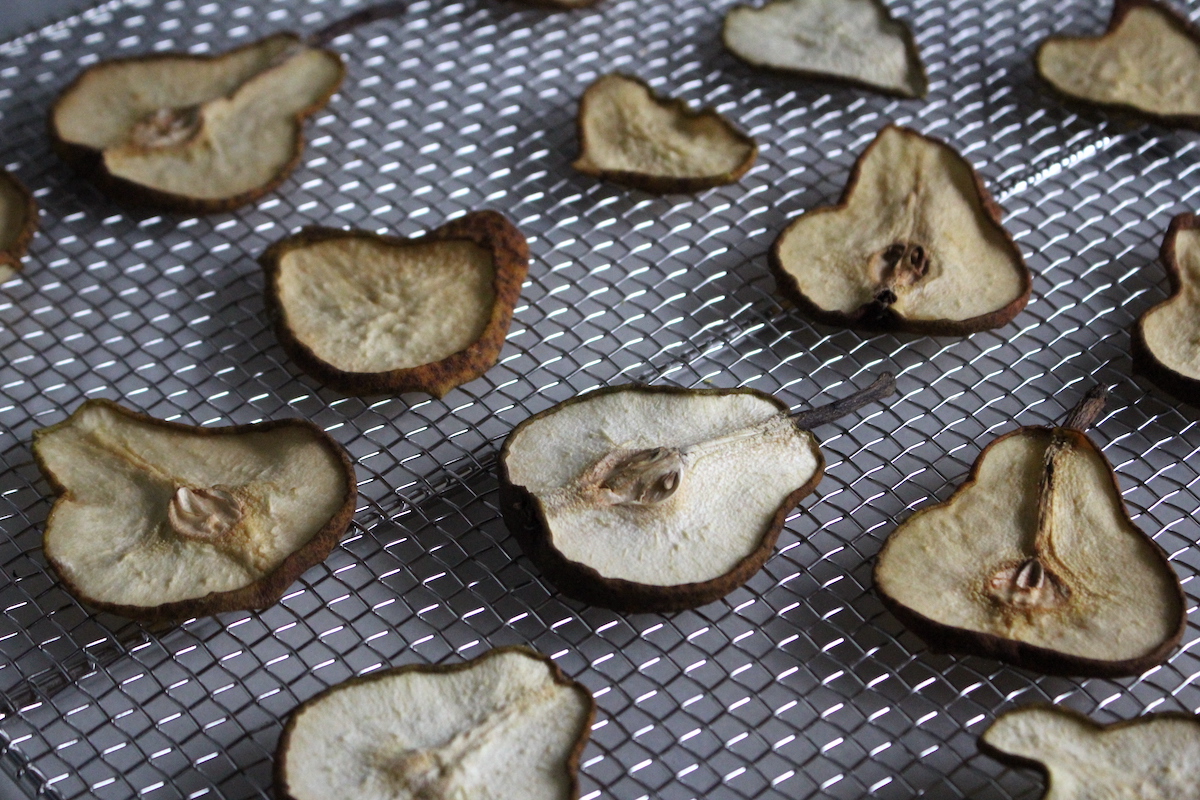
Table of Contents
Pears just don’t last all that long, not nearly as long as apples. It seems like they’re perfectly ripe for just minutes, but in truth, usually, they’re perfect for at least a few days before they start to go past prime.
Still, if you have a bumper crop of pears, it’s really difficult to use them all up in such a short time. Dehydrating to the rescue!
With no added ingredients, you can dehydrate pears into delicious pear chips to enjoy year-round. You’ll have all the flavor of a fresh pear, but in a much smaller package…and it won’t spoil on your counter. It’s the perfect solution!
Best Pears for Dehydrating
Some varieties of pear are better for dehydrating than others. Bartlett pears are an exceptional pear variety for drying, being at the ideal stage when they begin to develop a soft yellow hue, yet are still firm.
When dehydrating, you’ll want to stay away from pears that have gotten soft or mushy. You want to dehydrate your fruit while it’s sweet and ripe, but before it gets too soft. For great results, I suggest choosing to dehydrate pears just a day or two before you select them for eating.
Asian pears are another variety optimal for dehydrating — their crisp texture and sweet flavor make for a spectacular dried snack.
Some other pear varieties prime for dehydrating include:
- Giant Bartlett
- Green Bartlett
- Lincoln
- Bosc
- Anjou
- Concorde
- Asian Pears
Pears that ripen in late summer to early fall are wonderful choices for dehydrating. Winter pears will also dehydrate quite well; however, they won’t be as sweet as other varieties.
Be sure to select pears that are golden yellow with a rosy or reddish blush for optimal flavor.
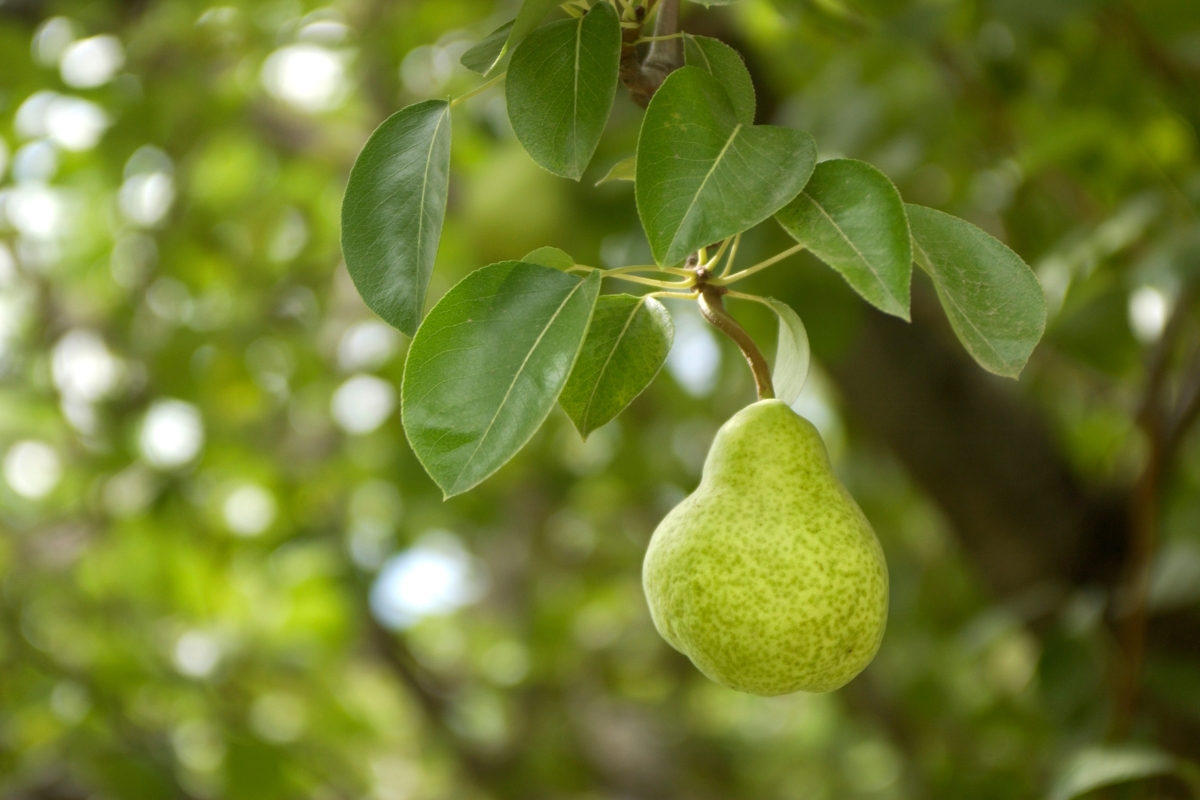
Preparing Pears for Drying
Begin by washing your pears and peeling them if desired. Peeling the outer skin of the pear is completely optional. Some find peeling pears will give the final result a better texture.
Next, slice your pears into desired sections. The most popular choice will be round slices, as with apple chips. Start by slicing pears into ¼ inch to ⅜ inch thick rounds, slicing pears thinner for crispier chips. You can also make use of a Mandoline slicer here if you have one.
Be sure to slice your rounds as uniformly as possible. A combination of thin and thick slices will not work and you’ll end up with portions that are either overdone or underdone. Try to keep your sections as evenly sized as possible. Use a paring knife to remove any seeds or bits of stem.
Additionally, you can core pears and cut them into quartered or eighth-sized chunks of fruit, just be sure to halve and core the fruit first. If you’re someone who loves pears, you may wish to invest in a pear corer. A pear corer tool is a nifty device with a loop sized perfectly right to scoop out the core of a pear and a smaller loop to destem the top.
Next, you’ll likely wish to pre-treat your pear slices with lemon juice or citric acid to combat browning (some also find lemon juice to enhance the flavor). Pears are a relatively low-acid fruit, so pre-treating with lemon juice, citric acid, or even vinegar is recommended.
Others find that pre-treating pear changes the flavor. Ultimately, the choice is yours.
If you wish to pre-treat your pear slices before dehydrating, refer to this outline from Penn State Extension Service:
“Pre-treat the pears in a solution of ½ teaspoon of powdered citric acid in 2 cups water or equal parts bottled lemon juice and water for ten minutes before placing them on trays to dry. This reduces oxidation, giving better color and enhancing the destruction of potentially harmful bacteria.”
Temperature for Drying Pears
Most home dehydrators will let you adjust your drying temperature. Excalibur and Cosori dehydrators have this feature, which is helpful if you’re dehydrating more than just simply jerky.
Pears, like many fruits, require moderate temperatures for dehydration. Pears are commonly dried at 135° F (57° C). This is an optimal temperature to ensure the fruit dries quickly without overheating and comprising taste.
Dehydrate at too high a temperature, and you’ll risk losing a lot of flavor in your final product.
If an oven is your only option for dehydrating, you’ll likely not be able to bake at this low of a temp. Most ovens have a minimum baking temp of 170° F. If oven-drying is your only choice, set your temperature as close to 135° F as possible and place your pear slices on wire racks that allow for air circulation like these stainless steel oven-safe racks.
How Long to Dehydrate Pears?
Pears can take anywhere from 20 to 36 hours to dehydrate fully in a dehydrator set at 135° F. If you slice your pears thin as per making pear chips or make much smaller half-inch chunks, your drying time will be less than this. Additionally, pears baked in an oven at a higher temperature, like these oven-dried Bosc pear chips, will take much less time (2 to 4 hours).
Time can vary depending on your pear variety as well as slice-thickness. Juicier pears and thicker pear slices and chunks will take longer than thinner slices or smaller chunks.
Even the humidity of the room your dehydrator is located in can affect drying times. Known as ambient humidity, the environment in which your dehydrator is located can affect the dehydration time. Dryer western states may result in shorter drying times than humid states in the South. Be sure to take your location and even your weather into consideration when estimating drying times.
Some dehydrators come equipped with a guide that provides recommended times based on ambient humidity. For pears, it says:
- 10 to 30% Humidity: 20 Hours
- 31 to 50% Humidity: 24 Hours
- 51 to 70% Humidity: 28 Hours
- 71 to 80% Humidity: 32 Hours
- Above 80% Humidity: 36 Hours
Pears should be done when they are dry to the touch with no mushy spots. They should not be so crisp they snap, however. The texture should still be pliable.
How to Dehydrate Pears in a Dehydrator
Set your dehydrator to 135° F. Place your pear rounds on the trays, making sure none of the slices are touching. Dehydrate for 20 to 36 hours, adjusting based on slice thickness, humidity, and moisture content of your fruit.
Your pear slices are finished once they dry to the touch with no wet spots. They should still be pliable when they come out and will crisp up once cooled.
How to Dehydrate Pears in the Oven
Using an oven for dehydrating doesn’t provide the same quality result as you’re usually dehydrating at much higher temperatures. Most ovens won’t allow for settings lower than 160° to 170° F — however, if your oven goes lower and possesses a good convection fan, it may be pretty decent for dehydrating.
When using an oven for dehydrating, the best course of action is to place oven-safe cooling racks atop baking sheets to allow for proper air circulation around your pear slices. Be sure the cooling racks you use are marked oven-safe like these stainless steel ones are; not all cooling racks are oven-safe!
Set your temperature to the lowest temperature it will allow, and dehydrate pears for 2 to 3 hours. If 200° F is the lowest setting, your pears may take as little as 1-½ to 2 hours.
Once again, be sure to note the thickness of your slices, as well as the moisture content of your pear variety, will affect the cooking time. An oven without a convection fan may also require a slightly longer cooking time.
Some also recommend wedging your oven door open with a wooden spoon to speed up the process, as this allows more moisture to escape the oven. If implementing this method, be sure to additionally run your hood fan to help with airflow.
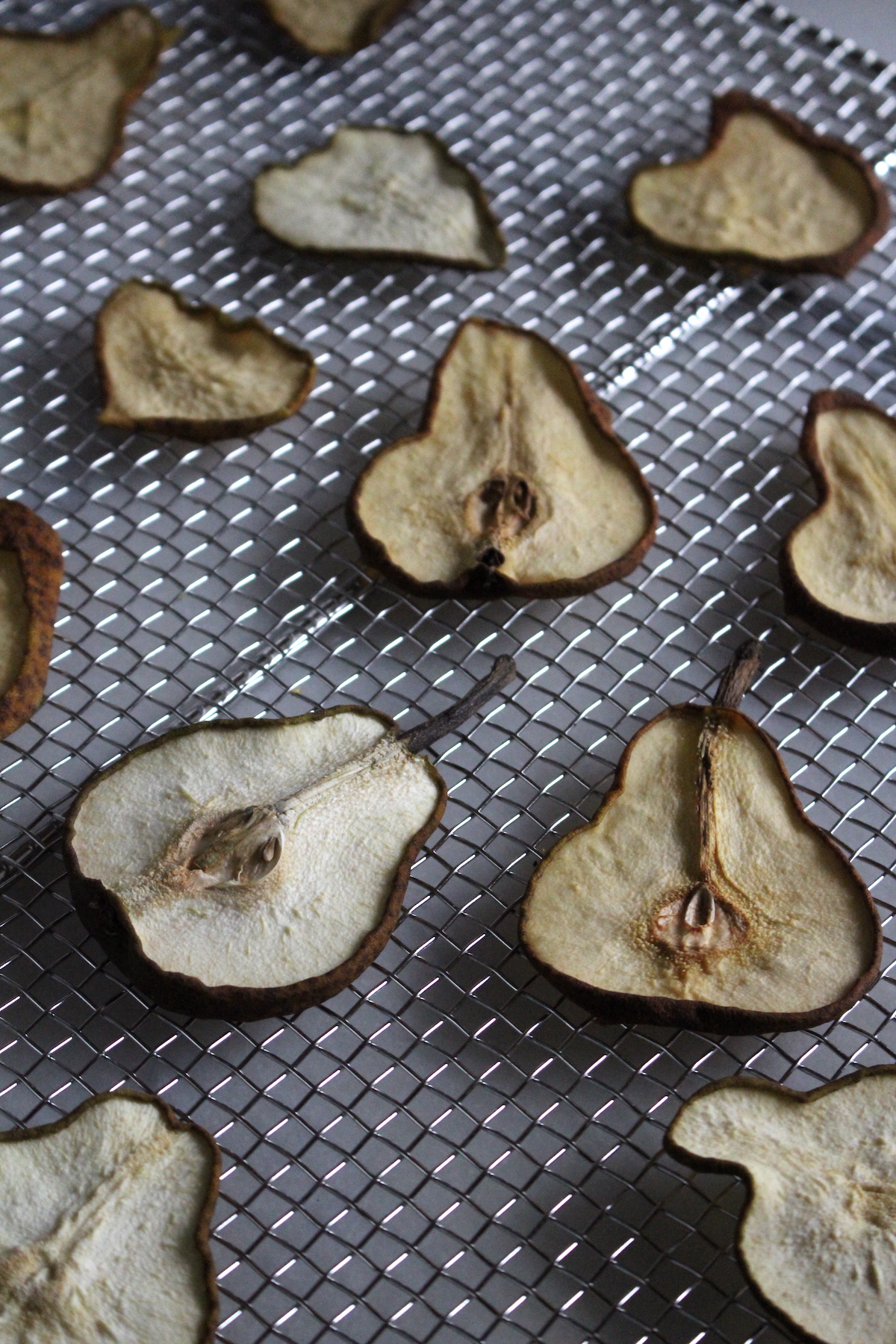
Fresh to Dried Yield
Dehydrating pears removes most of their weight, making them an ideal snack for taking on long hikes and backpacking adventures where excess weight is unwanted.
According to Colorado State University Extension, 14 pounds of fresh pears will yield just 1-½ pounds of dried pears or about 3 pints.
That means 4-½ pounds of pears should produce around a pint of pear slices when tightly packed. If packing loosely, though, say in a glass mason jar for pantry storage, this number will be less.
Ways to Use Dried Pears
Dried pears can be added to a wide variety of desserts and dishes to yield an array of appetizing plates. Consider adding dried pears to oatmeal, granola, yogurt, and cereal to inject a quick fruit flavor boost into breakfast.
Additionally, your delectable dried pears can be chopped and added to baked goods like this dried pear hazelnut loaf, winter bread pudding with dried pears.
Dried pears can also be diced and mixed with other dried fruits for a dried apple, pear and plum breakfast bread. Just slice and toast up for breakfast, slather with butter, and drizzle with honey for a sweet and warm treat to savor with your morning coffee.
But that’s not all dried pears can do. You can also rehydrate pears and use them just like fresh in desserts and baked goods like this dried pear cake or dried pear bread made by reconstituting dried pears in water. You can also plump up dried pears in juice or pear nectar as done in this dried pear and chocolate caramel tart for extra pear flavor.
Rehydrating fruit for pies used to be a common practice which has only recently been gaining recognition again. Pears can even be rehydrated for use in pies like this dried pear galette or for jam-making.
While fresh fruit is the most common ingredient used in jam-making today, dried fruit can also be utilized. You simply need to add additional moisture to your pot as you cook your mixture, be it extra juice, spirits, wine, or water. Also, know that dried fruits will take longer to turn into jam — about 45 minutes, whereas fresh fruit usually takes around 15 minutes.
Looking for a jam recipe for dried fruit? Try this dried fruit & rosehip jam.
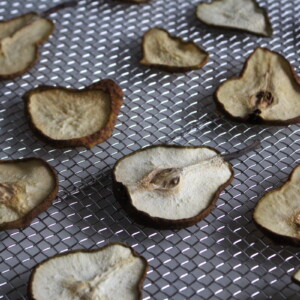
Dehydrating Pears
Ingredients
- 14 Pounds Pears, or however much you have, see notes
Instructions
- Wash pears before beginning. Peel pears if desired.
- Destem and slice pears into ¼ to ⅜ inch slices or core pears and cut into eighths or quarters.
- (optional) If you wish to pre-treat pear slices to lessen browning, briefly soak pear slices in a solution of water and citric acid or lemon juice for 10 minutes (either ½ teaspoon powdered citric acid in 2 cups water or equal parts bottled lemon juice and water will work).
- Dehydrator: Place pear slices or chunks onto dehydrator trays, ensuring they do not overlap. Set your dehydrator to 135° F and dehydrate for 20 to 36 hours. Pears are adequately dehydrated when they are dry to the touch, yet still pliable.
- Oven: To dehydrate pears in the oven, place pears on oven-safe drying racks atop baking sheets. Set your oven as low as it will go (160° to 170° F is as low as most will go) and turn on your convection fan to quicken drying time if your oven is equipped with one. Oven-dried pears will bake much faster — check for doneness around 2 to 4 hours.
Notes
Conditioning
Be sure to condition your pears before long-term storage. Conditioning helps to distribute moisture and ensure your fruit is adequately dehydrated to protect from spoiling. To condition pears, allow pears slices to cool for at least 30 minutes after dehydrating and then move to a large container, filling to about ⅔ of the way full. Cover and store in a dry location for 4 to 10 days, stirring or shaking the contents once a day. If you see beads of moisture forming inside your container, your pear slices are not fully dehydrated. Return pears to the dehydrator for additional drying and repeat the conditioning process again.Dehydrating Time
The length of time needed for dehydrating pears depends on multiple factors including the size of your slices, the moisture content of your particular pear variety, and the ambient humidity of your locale. Drying times vary based on local humidity. See the chart below for reference:- 10 to 30% Humidity: 20 Hours
- 31 to 50% Humidity: 24 Hours
- 51 to 70% Humidity: 28 Hours
- 71 to 80% Humidity: 32 Hours
- Above 80% Humidity: 36 Hours
Yield
14 pounds of fresh pears will dehydrate down to 1-½ pounds (around 3 pints) of dried pear.Ways to Preserve Pears
Making pear chips isn’t the only way to preserve this appetizing fruit!
Consider making pear sauce — a treat very akin to applesauce, as well as jams and jellies.
Be sure to try your hand at pear butter as well. Pear butter is sensational spread on toast and muffins, especially this maple whiskey pear butter.
When in overabundance, pears can also be canned or turned into scintillating ciders and fruit wines.
- Pear Sauce
- Pear Jam
- Pear Jelly
- Pear Butter
- Canning Pears
- How to Make Pear Cider (Hard or Sweet)
- Pear Wine
Dehydrator Recipes
Looking for more dehydrator recipes?
- Dehydrating Pineapple
- Dehydrating Carrots
- How to Make Fruit Leather
- How to Make Yogurt in the Dehydrator
